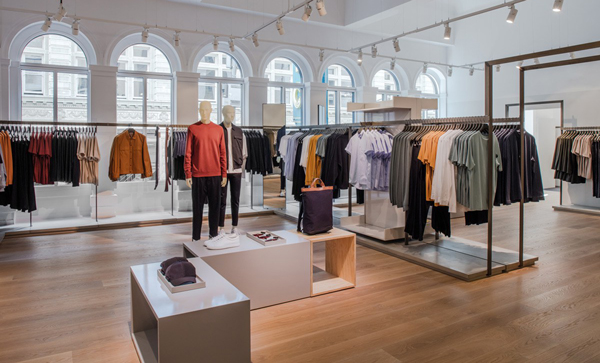Trending
DTLA retail goes top shelf

Some of Los Angeles’ most desirable brands have snapped up leases in Downtown L.A. in recent months, but there’s still a long way to go before the area will rival other major urban shopping destinations, local experts said.
“What we have here today is still not on par with other urban centers like Chicago, but we have to remember that in 2004, we didn’t have any retail in DTLA at all,” said Brigham Yen, a Realtor with commercial brokerage Miren.co and former economic development associate with the Downtown Center Business Improvement District (DCBID).
The seeds of the neighborhood’s retail rejuvenation were largely planted as far back as 2012, when construction of the FIGat7th complex at 735 South Figueroa Street was completed. The development held the promise of luring new national retail tenants to the area, and with Target, H&M, Zara and others in place, the shopping center added a 27,000-square-foot Nordstrom Rack as one of its anchors in October 2017.
Brookfield Properties, the FIGat7th developer, plans to add a 64-story building west of the shopping center that would house hundreds of condos and ground-floor retail space. The addition is slated for a 2019 completion.
“FIGat7th brought people back to Downtown to shop,” Yen said. “Now, even on Sunday, there are people walking on Figueroa Street between Seventh and Eighth streets. It proved to retailers that downtown is a viable market.”
Broadway gets lit
The Broadway theater district, which encompasses Broadway between Sixth and 11th streets, was once the entertainment epicenter of L.A., drawing throngs of visitors to massive department stores and multiple movie theaters. Today, the area is lighting up once again, in part because of adaptive reuse projects that are turning commercial properties into modern concepts that combine housing, dining, retail and entertainment offerings.
A host of trendy retailers have recently gobbled up space in the area.
Contemporary fashion brand Theory leased 1,650 square feet in a former Pilates studio space at the Eastern Columbia Building, signing a deal for the space in the fourth quarter of 2017. The shop sits alongside German eyewear brand MYKITA, which began leasing in the historic Art Deco building at 849 South Broadway in late 2016.

Aaron Weiner, The Tenant Group
Andrea Lieberman Collection, known as A.L.C., opened next to the Orpheum Theatre on Broadway in a former optometry office in July. The 1,350-square-foot space is A.L.C.’s first brick-and-mortar store.
Another newcomer to brick and mortar made landfall in the fourth quarter of 2017 in DTLA: Tech gear brand InCase opened its first-ever retail
location in the Sparkle Factory at 910 South Broadway. InCase joins a cluster of retailers across the street from the trendy Ace Hotel at Broadway and Ninth Street, including stores like Tanner Goods, Aesop, BNKR, Acne Studios and A.P.C.
The Olympic Theatre building, at 816 South Broadway, also inked deals with a handful of hip brands toward the end of 2017. High-end South Korean eyewear retailer Gentle Monster opened its first L.A. shop in a 10,000-square-foot space there. And Yen represented landlord Titan Metropolis to bring fashion brand COS to the building. The minimalist retailer is part of the H&M Group. It had previously tested the waters with a pop-up shop in DTLA. In the third quarter, it went all in with a 5,511-square-foot flagship location in the building.
And still more retailers are due to flow into the area. This spring, footwear brand Vans will open an 8,000-square-foot flagship store on the entire first floor of the Singer Sewing Building at 806 South Broadway, joining a growing roster of shoe stores nearby; there’s also a proposed Jordan Brand store from Nike at 620 South Broadway.
An Apple store, too, will arrive in 2018, opening in Tower Theatre at Broadway and Eighth Street. According to Yen, Apple plans to incorporate its store design into the existing ornate design of the building, which includes 7,500 square feet of ground-floor theater space with another 7,500 square feet of basement space.
Arts District, activated
The Arts District, roughly defined by Alameda Street, the Los Angeles River, the 101 Freeway and the 10 Freeway, is getting a lot of attention from developers hoping to cash in on leasing activity before the area becomes overdeveloped, sources said. At the close of 2017, a total of more than 2.5 million square feet of commercial space was proposed for the area, according to a DCBID report. The majority of these projects included some type of retail space.
The three-phase, $2 billion development known as 6AM, for example, is slated for a 2035 completion and will include 128,000 square feet of retail, 1,500 residential units, 412 hotel rooms and 250,000 square feet of office space. The complex will be punctuated by the Arts District’s first-ever skyscrapers. The pair of 58-story buildings will be constructed on about 15 acres at the corner of Sixth and Alameda streets. The developer, SunCal, has hired international firm Herzog & de Meuron to design the development in collaboration with local firms AC Martin and Mia Lehrer + Associates.
Also in the Arts District, Vancouver-based Omni Group is proposing a 13-story structure at 2143 Violet Street with 288,000 square feet of retail and 509 residential units. The project is still in the planning stages.
And another one of the area’s biggest projects is currently poised to flourish, though it will feature less retail space than originally planned. Construction on the $80 million At Mateo project in the Arts District concluded in October 2017. A joint venture between ASB Real Estate Investments and Blatteis & Schnur, the project includes multiple low-rise office buildings with ground-floor retail, as well as an adjoining 540-car parking structure.
 In the second quarter of 2017, liquid-meal replacement maker Soylent signed a lease for 29,000 square feet of office space in At Mateo, prompting developers to quietly reduce the center’s retail offerings. “Time will tell what the retail mix will turn out to be,” said Aaron Weiner, executive vice president of the Tenant Group on Wilshire.
In the second quarter of 2017, liquid-meal replacement maker Soylent signed a lease for 29,000 square feet of office space in At Mateo, prompting developers to quietly reduce the center’s retail offerings. “Time will tell what the retail mix will turn out to be,” said Aaron Weiner, executive vice president of the Tenant Group on Wilshire.
The massive mixed-use project ROW DTLA, at 777 Alameda Street in the Arts District, was also completed in 2017. Developed by Atlas Property, the project features 1.2 million square feet of office space and 200,000 square feet of retail space.
Although the retail space is not yet filled, “much of the retail there will feature a blend of manufacturing and consumer sales, like huge bakeries and breweries,” said Weiner, who is familiar with the property. The space is also the home to the Sunday-afternoon Smorgasburg food fair.
Leasing letdown
While the influx of retailers is encouraging — particularly in the context of the continuing struggle for brick-and-mortar shops across the county — DTLA still has quite a ways to go before it’s deemed a success for retail. As of the third quarter of 2017, there were 1,547,300 square feet of retail space under construction in DTLA, according to a DCBID market report.
“There has been a big surge in retail space development in Downtown L.A.,” Weiner said. “Literally every new residential building has 5,000 to 15,000 square feet of retail space at street level. Every month, some new building opens, adding fresh retail space.”
Surprisingly, leasing rates are up even as the amount of unabsorbed retail space grows. The average DTLA rent per square foot was $2.57 a month in the third quarter of 2017, up from $2.51 at the same time in 2016, according to CoStar data. At the close of Q3 2017, the DTLA retail vacancy rate was 4.6 percent, up from 4 percent the previous year.
The large volume of retail space in the pipeline is expected to drive that rate up further, particularly as some existing projects are still on the hunt for tenants. For example, the Bloc open-air retail destination opened with much ado in summer 2016. Although great excitement initially surrounded the rework of Macy’s Plaza, and it was developed by an experienced firm, the Ratkovich Company, the project encountered many pitfalls, including bailing tenants and financing difficulties — which have since been resolved — and has yet to become fully leased. “This project was expected to show the new face of Downtown retail,” said Weiner. “The project is open and beautiful, but leasing has been surprisingly slow.”
Retailers like Sephora and Trina Turk passed on leasing agreements at the Bloc, and insiders said the shopping center may continue to struggle, considering that there is an increasing number of options for prospective lessees.
Even with the specter of a glut, few landlords have started to budge on rates. With rent prices rising, “landlords have become noncommittal to engaging in long-term leases. This is out of fear that the neighborhood dynamics can change and leave them with a tenant who is not paying market rent or is no longer a fit for the area,” said Farid Yaghoubtil, an attorney whose firm, Downtown L.A. Law Group, negotiates lease agreements.
Additionally, lease terms have become more complicated, Yaghoubtil said. “We are noticing a higher level of sophistication from both sides of the fence. Landlords are engaging attorneys to negotiate leases, and potential tenants are also seeking legal help in navigating certain issues,” he added.
Some of the retailers most at risk for high rates are restaurants and smaller operations that do not have corporate backing. Currently, landlords hold the leverage at the negotiating table, Yaghoubtil said, and it is the smaller retailers who are paying the highest rates.
On the horizon
As more retail space becomes available, all eyes are on Oceanwide Plaza at 1101 South Flower Street. This $1 billion megadevelopment across from Staples Center is expected to have 166,000 square feet of retail space, 504 condos and a 184-key Park Hyatt hotel. It’s the first North American project for Beijing developer Oceanwide Holdings and is slated for an early-2019 completion.
“It will be another important piece of the puzzle for Downtown L.A.,” said Yen. “I think we’ll see a mixture of neighborhood-serving retail there, plus some international retail luxury brands— maybe our first Coach store or Louis Vuitton. Three years ago, that seemed impossible.”



